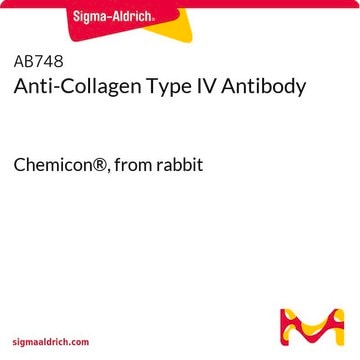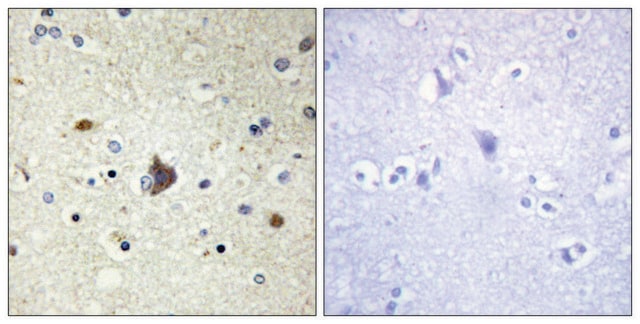AB756P
Anti-Collagen Antibody, Type IV
Chemicon®, from rabbit
Synonim(y):
Anti-ATS2, Anti-CA44
About This Item
Polecane produkty
pochodzenie biologiczne
rabbit
Poziom jakości
forma przeciwciała
purified antibody
rodzaj przeciwciała
primary antibodies
klon
polyclonal
reaktywność gatunkowa
mouse
producent / nazwa handlowa
Chemicon®
metody
ELISA: suitable
immunofluorescence: suitable
immunohistochemistry: suitable (paraffin)
przydatność
not suitable for Western blot
numer dostępu UniProt
Warunki transportu
dry ice
docelowa modyfikacja potranslacyjna
unmodified
Opis ogólny
Specyficzność
Immunogen
Zastosowanie
A previous lot of this antibody was used in ELISA at >1:200 (OD >500).
Immunofluorescence:
A previous lot of this antibody was used in immunofluorescence.
Immunohistochemistry:
1:80 dilution for immunofluorescent staining of fresh frozen mouse skin and liver tissues. Acetone or methyl-carnoy fixed paraffin-embedded tissue (mouse skin and liver) is also reactive.
Not recommended for Western blots.
Optimal working dilutions must be determined by end user.
Cell Structure
ECM Proteins
Opis wartości docelowych
Powiązanie
Postać fizyczna
Przechowywanie i stabilność
Komentarz do analizy
Positive Control: Kidney, muscle, tendon spleen tissue, mouse liver. Negative Control: Neurons/glia.
Inne uwagi
Informacje prawne
Oświadczenie o zrzeczeniu się odpowiedzialności
Not finding the right product?
Try our Narzędzie selektora produktów.
Kod klasy składowania
12 - Non Combustible Liquids
Klasa zagrożenia wodnego (WGK)
WGK 1
Temperatura zapłonu (°F)
Not applicable
Temperatura zapłonu (°C)
Not applicable
Certyfikaty analizy (CoA)
Poszukaj Certyfikaty analizy (CoA), wpisując numer partii/serii produktów. Numery serii i partii można znaleźć na etykiecie produktu po słowach „seria” lub „partia”.
Masz już ten produkt?
Dokumenty związane z niedawno zakupionymi produktami zostały zamieszczone w Bibliotece dokumentów.
Nasz zespół naukowców ma doświadczenie we wszystkich obszarach badań, w tym w naukach przyrodniczych, materiałoznawstwie, syntezie chemicznej, chromatografii, analityce i wielu innych dziedzinach.
Skontaktuj się z zespołem ds. pomocy technicznej








